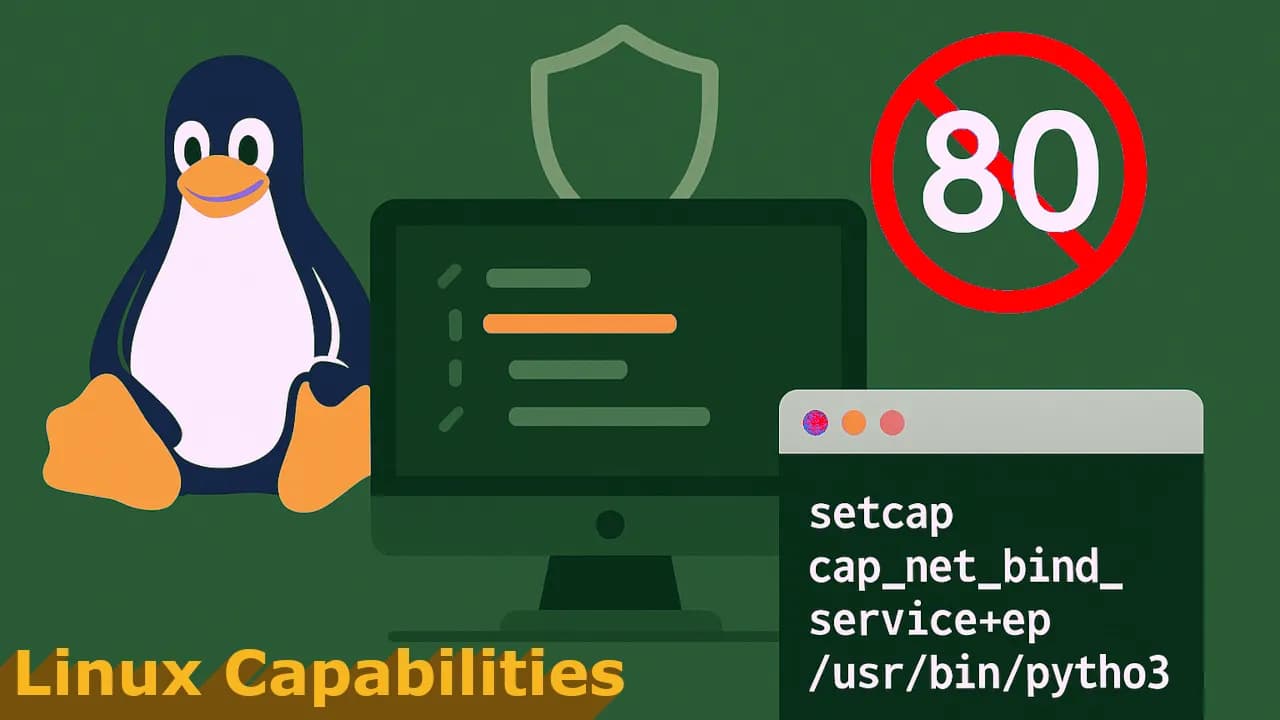Binding to privileged ports like port 80 (HTTP) typically requires root privileges on Linux systems, as ports below 1024 are restricted for security reasons. However, running applications as root introduces significant security risks. Linux capabilities provide a safer alternative, allowing non-root processes to perform specific privileged tasks, such as binding to low-numbered ports, without granting full root access. In this blog post, we’ll explore how to use Linux capabilities to bind to port 80 without root, with practical code examples and step-by-step instructions.
This guide is ideal for developers, system administrators, or DevOps engineers aiming to enhance application security while maintaining functionality. Let’s get started!
What Are Linux Capabilities?
Linux capabilities divide root privileges into granular units, enabling processes to perform specific tasks without full superuser access. For binding to port 80, the key capability is CAP_NET_BIND_SERVICE, which allows a process to bind to privileged ports (below 1024).
Using CAP_NET_BIND_SERVICE, you can run a web server (e.g., Python or Node.js) as a non-root user while still binding to port 80 or 443, reducing the attack surface if the process is compromised.
Why Avoid Running as Root?
Running a web server as root is risky because:
- A vulnerability could grant an attacker full system control.
- Root processes can modify system files, access sensitive data, or disrupt other processes.
- The principle of least privilege recommends granting only the permissions needed.
Linux capabilities mitigate these risks by limiting a process’s privileges to only what’s necessary.
Step-by-Step: Binding to Port 80 with CAP_NET_BIND_SERVICE
Let’s set up a simple web server that binds to port 80 without root privileges. We’ll use a Python HTTP server as an example, but the approach applies to any application (e.g., Node.js, Nginx).
Prerequisites
- A Linux system (e.g., Ubuntu, Debian, or CentOS).
- Python 3 installed (for the example code).
-
The
libcappackage installed (sudo apt install libcap2-binon Debian/Ubuntu orsudo yum install libcapon CentOS).
Step 1: Create a Simple Web Server
Here’s a basic Python HTTP server that attempts to bind to port 80:
pythonimport http.server
import socketserver
PORT = 80
Handler = http.server.SimpleHTTPRequestHandler
with socketserver.TCPServer(("", PORT), Handler) as httpd:
print(f"Serving HTTP on port {PORT}")
httpd.serve_forever()
Save this as server.py. Running it as a non-root user (python3 server.py) will result in a PermissionError: [Errno 13] Permission denied, as binding to port 80 requires elevated privileges.
Step 2: Grant CAP_NET_BIND_SERVICE to the Python Binary
To allow this script to bind to port 80 without root, assign the CAP_NET_BIND_SERVICE capability to the Python binary using the setcap command:
bashsudo setcap 'cap_net_bind_service=+ep' /usr/bin/python3
-
cap_net_bind_service: Permits binding to privileged ports. -
+ep: Adds the capability to both effective and permitted sets, enabling the process to use it. -
/usr/bin/python3: The path to the Python binary (verify withwhich python3).
Step 3: Run the Server as a Non-Root User
Run the server again as a non-root user:
bashpython3 server.py
The server should now bind to port 80 successfully. Visit http://localhost in a browser to confirm it’s serving content.
Step 4: Verify Capabilities
Check that the capability was applied using getcap:
bashgetcap /usr/bin/python3
Expected output:
/usr/bin/python3 = cap_net_bind_service+ep
This confirms the Python binary has the required capability.
Real-World Example: Node.js Web Server
Let’s apply the same concept to a Node.js application. Here’s a simple Node.js server binding to port 80:
javascriptconst http = require('http');
const PORT = 80;
const server = http.createServer((req, res) => {
res.writeHead(200, { 'Content-Type': 'text/plain' });
res.end('Hello, World!\n');
});
server.listen(PORT, () => {
console.log(`Server running on port ${PORT}`);
});
Save this as server.js. Running node server.js as a non-root user will fail with a permission error. To fix this, apply the capability to the Node.js binary:
bashsudo setcap 'cap_net_bind_service=+ep' /usr/bin/node
Now, run the server:
bashnode server.js
The server should bind to port 80 and display “Hello, World!” at http://localhost.
Alternative: Using a Systemd Service
In production, you might run your application as a systemd service. Systemd allows setting capabilities directly in the service configuration, avoiding modifications to the binary.
Here’s a systemd service file for the Python server:
ini[Unit]
Description=Python HTTP Server
After=network.target
[Service]
ExecStart=/usr/bin/python3 /path/to/server.py
Restart=always
User=nobody
Group=nogroup
AmbientCapabilities=CAP_NET_BIND_SERVICE
CapabilityBoundingSet=CAP_NET_BIND_SERVICE
[Install]
WantedBy=multi-user.target
-
Save this as
/etc/systemd/system/webserver.service. - Reload systemd and start the service:
bashsudo systemctl daemon-reload
sudo systemctl start webserver
sudo systemctl enable webserver
The AmbientCapabilities and CapabilityBoundingSet directives ensure the service runs with only CAP_NET_BIND_SERVICE, and User=nobody runs it as a low-privilege user.
Security Considerations
-
Limit Capabilities: Grant only the necessary capabilities. Use
CapabilityBoundingSetin systemd or remove unneeded capabilities from binaries. - File Permissions: Ensure the binary or script isn’t writable by untrusted users to prevent capability abuse.
-
Regular Audits: Use
getcapto review capabilities on binaries and verify their necessity. -
Non-Root Users: Run services as non-root users (e.g.,
nobody) to limit potential exploit damage.
Troubleshooting Common Issues
-
Permission Denied Error: Verify the
setcapcommand was applied to the correct binary (check withwhich python3orwhich node). -
Capability Not Persisting: Package updates may overwrite binaries, removing capabilities. Reapply
setcapor use a systemd service. -
Systemd Issues: Ensure the service file syntax is correct and the specified
UserandGroupexist.
Conclusion
Using CAP_NET_BIND_SERVICE allows you to bind to privileged ports like 80 without root privileges, enhancing security for your web applications. Whether using Python, Node.js, or another language, the process is simple with setcap or systemd. By following this guide, you can deploy secure, non-root web servers with ease.
Album of the day:




